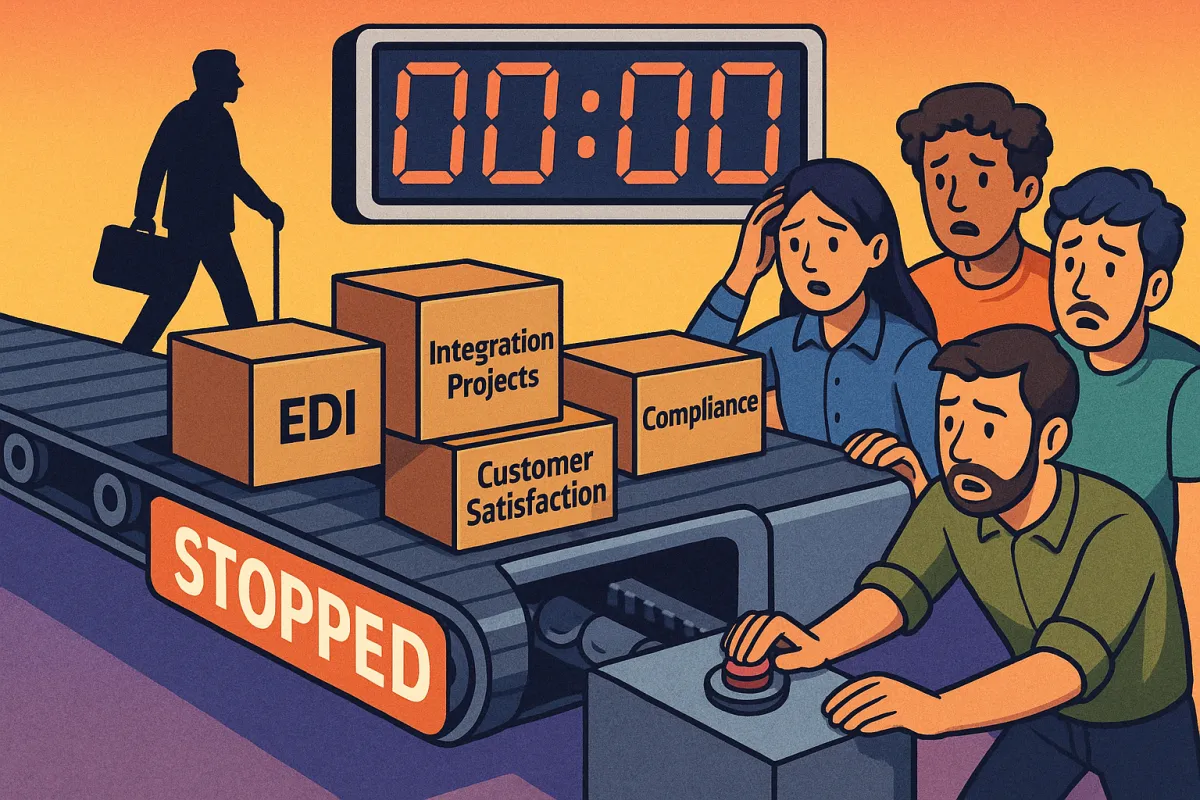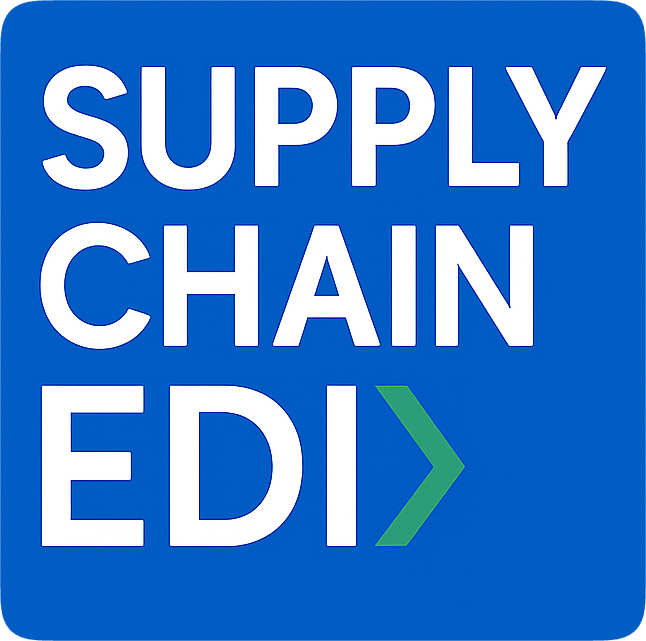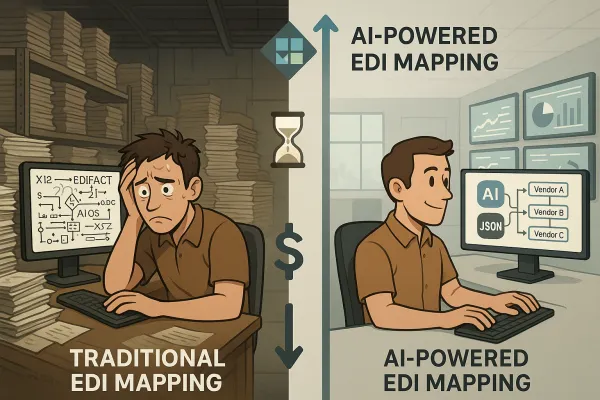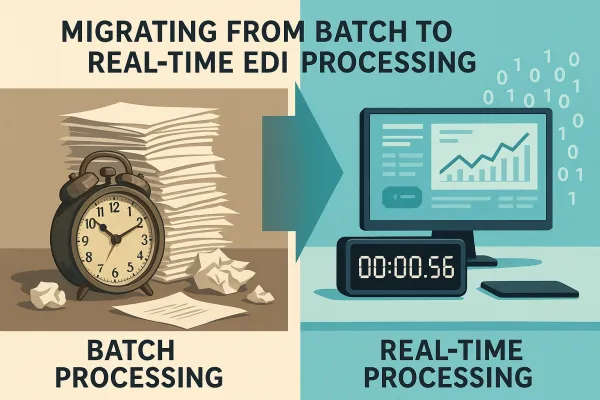Solving the EDI Skills Crisis: A Strategic Workforce Development Guide for 2025

Twenty-nine percent of businesses say they lack the skilled resources to build and manage integrations between systems, and the problem runs deeper than most supply chain IT directors realize. Many professionals who initially implemented and managed EDI systems are now reaching retirement age, taking with them years of specialized knowledge, while EDI professionals are in high demand but there is a limited supply. This isn't just about finding people who can map transactions or troubleshoot connection errors. By 2026, more than 90% of organizations worldwide will feel the pain of the IT skills crisis, amounting to some $5.5 trillion in losses caused by product delays, impaired competitiveness, and loss of business.
The EDI workforce development crisis demands immediate strategic action. Companies can no longer assume their integration expertise will persist through organic hiring or hope that senior EDI analysts will stick around indefinitely. You need a comprehensive approach that builds internal capabilities while reducing dependence on scarce external talent.
The Scale of the EDI Skills Crisis
The numbers tell a stark story. A lack of cloud skills cost businesses up to $258 million annually, according to the London School of Economics, and EDI modernization efforts suffer similar financial impacts. A growing shortage of trained EDI professionals is leaving many companies struggling to maintain and expand EDI capabilities, particularly in manufacturing, retail, and healthcare where B2B communication requirements continue expanding.
In a recent International Data Corporation survey of North American IT leaders, nearly two thirds said that a lack of skills has resulted in missed revenue growth objectives, quality problems, and a decline in customer satisfaction. When your lead EDI specialist gives two weeks' notice, you're not just losing technical knowledge - you're risking compliance failures, partner relationship disruptions, and delayed implementations that can cost hundreds of thousands in lost opportunities.
When onboarding resources from outside your organization experience comes with a price, particularly in a tight market. Senior EDI consultants now command $150-200 per hour for project work, and finding qualified contractors for six-month implementations has become increasingly difficult. The hidden costs compound quickly: project delays, extended learning curves for replacement staff, and the constant risk of single points of failure in critical integration workflows.
Root Causes Behind the EDI Talent Drain
While many universities and technical schools offer degrees in information technology, computer science, and business management, EDI is rarely a focus of these programs. As a result, few graduates enter the workforce with a specific understanding of EDI systems, protocols, and standards. Most EDI professionals learn on the job, picking up knowledge as they go, which makes it difficult to scale expertise across the industry.
The perception problem runs deeper than curriculum gaps. Newer technologies such as APIs and blockchain are becoming more prevalent in supply chain management, leading to concerns that EDI will eventually be phased out or replaced. This perception may discourage younger professionals from pursuing careers in EDI. Yet the EDI market is projected to reach $49.21 billion by 2027, proving these assumptions wrong.
The truly homegrown EDI solutions are often so complex that there is only a single in-house expert that truly understands how it all works. This creates dangerous knowledge silos where retirement, illness, or job changes can cripple operations overnight. Companies using transportation management solutions from MercuryGate, Descartes, or emerging platforms still face these challenges because the integration expertise remains concentrated in a few individuals.
The Hidden Costs of EDI Skills Gaps
The financial impact extends beyond consultant fees and salary inflation. Project delays cascade through supply chain operations, affecting partner onboarding timelines and compliance deadlines. Businesses are concerned about the loss of customers and orders and the shortage of EDI and data integration talent.
When skilled EDI staff leave, replacement costs include:
- 3-6 months of reduced productivity while new hires learn proprietary mapping configurations
- Increased consultant dependency for routine maintenance and updates
- Higher error rates during the knowledge transfer period
- Delayed integration projects that could impact partner relationships
- Compliance risks if documentation and change management processes weren't properly maintained
Strategic Workforce Development Solutions
Building sustainable EDI capabilities requires moving beyond traditional hiring approaches. Investing in internal training programs and mentorship opportunities can help companies build a pipeline of EDI talent from within their own workforce. By pairing new hires with experienced professionals, organizations ensure valuable institutional knowledge is passed on.
Start with cross-training existing IT staff who already understand your business processes and technical infrastructure. Database administrators, system analysts, and even help desk technicians often possess foundational skills that can be developed into EDI competency. The key is structured learning paths that combine hands-on experience with formal training modules.
Create EDI centers of excellence that document standard procedures, maintain testing environments, and establish clear escalation paths. This approach reduces dependence on individual expertise while building organizational knowledge that survives personnel changes. Good consulting organizations will educate your team as part of their deliverable, and not leave you dependent on them.
Modern Training Approaches That Work
Traditional classroom training for EDI often fails because learners can't immediately apply concepts to real-world scenarios. Effective programs combine theoretical knowledge with sandbox environments where trainees can practice mapping exercises, test error scenarios, and experiment with different protocol configurations.
Cloud-based EDI platforms simplify the learning curve by removing infrastructure complexity. Platforms like Cleo, TrueCommerce, SPS Commerce, and Cargoson provide test environments where new users can gain hands-on experience without risking production systems. This makes EDI more accessible to IT generalists who might otherwise be intimidated by traditional EDI complexity.
Gamification elements - achievement badges for completing mapping exercises, leaderboards for error-free test transmissions - keep learners engaged through the often mundane aspects of EDI configuration. Pair this with mentorship programs where senior staff provide regular feedback and guidance.
Certification programs from EDI providers and industry associations provide structured learning paths and external validation of skills. While not guaranteeing competence, they demonstrate commitment to professional development and provide benchmarks for skill assessment.
Succession Planning for EDI Operations
The lack of effective knowledge transfer within organizations exacerbates the problem, as new hires often face a steep learning curve when it comes to understanding legacy systems and the complexities of EDI implementation and integration. Effective succession planning starts with documenting tribal knowledge before it walks out the door.
Create comprehensive runbooks that document not just technical procedures but business context: why certain mapping decisions were made, how specific partners prefer to handle exceptions, which integration patterns work best for different transaction types. Video recordings of senior staff explaining complex configurations prove invaluable when those experts are no longer available.
Establish redundancy in critical EDI roles by cross-training at least two people on each major partner integration. Rotate responsibilities periodically to ensure knowledge doesn't stagnate with one person. Build relationships with multiple EDI training providers and maintain connections with qualified consultants who understand your environment.
Regular knowledge transfer sessions - monthly brown-bag presentations where team members share lessons learned from recent projects - help distribute expertise across the team while identifying gaps in documentation or understanding.
Technology Solutions to Reduce Skills Dependencies
Modern EDI platforms with intuitive interfaces reduce the specialized knowledge required for routine operations. Pre-built connectors and templates minimize custom development work, while AI-powered mapping assistance helps identify data transformation errors that might otherwise require expert intervention.
Self-service capabilities enable business users to handle basic partner onboarding and document modifications without involving IT staff. Platforms like nShift, Transporeon, and Cargoson emphasize user-friendly interfaces that reduce the learning curve for non-technical staff.
AI can help to automate and streamline EDI-based processes including automating data entry and conversion, and identifying and correcting errors in EDI data, which can help to improve the accuracy of B2B transactions. These capabilities reduce dependence on human expertise for routine error detection and resolution.
Consider managed services for non-critical integrations to free up internal resources for strategic initiatives. EDI modernization could also mean outsourcing your EDI workflows to experts as an integration center of excellence, which enables you to focus more on business goals and less on the minutiae of managing integrations.
Implementation Roadmap: Getting Started
Begin with a skills inventory assessment that identifies current EDI competencies across your organization. Document not just technical skills but also business knowledge about partner requirements, industry standards, and compliance obligations. This baseline helps prioritize training investments and identify immediate succession planning needs.
Develop partnerships with local universities and technical schools to create EDI-focused curriculum modules. Collaborations between businesses and academic institutions can create specialized EDI training courses or certifications as part of broader IT or supply chain management programs. These initiatives help equip the next generation with the skills needed to manage and evolve EDI systems.
Create incentive structures that reward EDI skill development. Access to new technology has been noted to be as motivating as salary as a key driver in employee satisfaction. Offer training budgets, conference attendance, and career advancement opportunities tied to integration expertise.
Measure success through specific metrics: time to onboard new EDI staff, error rates in integration projects, partner satisfaction scores, and internal knowledge transfer assessments. Set realistic timelines - building comprehensive EDI competency takes 12-18 months of focused development.
Budget considerations should include training costs ($5,000-15,000 per person for comprehensive programs), temporary consultant support during knowledge transfer periods, and technology investments in modern platforms that reduce skills dependencies. The ROI calculation is straightforward: compare these costs against the risk of losing critical integration capabilities or the ongoing expense of external consultants.
The EDI skills shortage won't resolve itself through traditional hiring approaches. Organizations that invest now in comprehensive workforce development strategies will maintain competitive advantages in supply chain integration while others struggle with consultant dependencies and knowledge gaps. Start with succession planning for your most critical integrations, then build systematic training programs that create sustainable expertise across your team.





